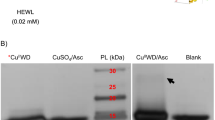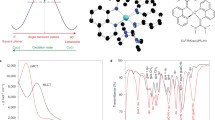Abstract
Photocleavage of chicken hen egglysozyme by three Co(III)ammine complexes, hexamminecobalt(III) chloride ([Co(NH3)6]+3), pentamminechloro cobalt(III)chloride ([Co(NH3)5Cl]+2), and tetramminecarbonato cobalt(III) nitrate ([Co(NH3)4CO3]+), is reported here. Photocleavage resulted in two fragments of molecular masses of ~10.5 kDa and ~3.5 kDa which add-up to that of the parent molar mass. Detailed studies on the influence of irradiation time, excitation wavelength, the type of ligand coordinated to Co(III), concentration of the metal complex, the addition of competing metal ions, and quenchers on the protein photocleavage are reported. The Co(III) complexes also photocleaved apotransferrin, bovine serum albumin, and yeast enolase. Near-equimolar concentrations of Ni(II), Co(II) or Gd(III) inhibited the photocleavage, and therefore, binding of Co(III) metal complexes to Ni(II)/Co(II)/Gd(III)binding sites on lysozyme is necessary for the observed photocleavage. Since these ions are known to bind to Asp52 on lysozyme, we suspect that the above Co(III) complexes bind at this site, and initiate the protein cleavage. The Co(III) complexes have appropriate photochemical reactivities to cleave the peptide backbone, and they may be useful in the design of novel photochemical approaches to cleave the protein backbone.
Similar content being viewed by others
References
E. Ochiai, in Bioinorganic Chemistry. An Introduction, Allyn and Bacon Inc., Boston, 1977.
G. S. Jackson, I. Murray, L. L. P. Hosszu, N. Gibbs, J. P. Waltho, A. R. Clarke and J. Collinge, Location and properties of metal-binding sites on the human prion protein, Proc. Natl. Acad. Sci. USA, 2001, 98, 8531–8535.
C. M. Lambert and M. L. Gross, Location of alkali metal binding sites in endothelin A selective receptor antagonists, cyclo(D-Trp-D-Asp-Pro-D-Val-Leu) and cyclo(D-Trp-D-Asp-Pro-D-Ile-Leu), from multistep collisionally activated decompositions, J. Mass. Spec., 2000, 35, 265–276.
C. V. Kumar and A. Buranaprapuk, Site-specific photocleavage of proteins, Angew. Chem., 1997, 36, 2085.
C. V. Kumar, A. Buranaprapuk, G. Opiteck, M. B. Moyer, S. Jockusch and N. J. Turro, Photochemical protease: site-specific photocleavage of hen egg lysozyme and bovine serum albumin, Proc. Natl. Acad. Sci. USA, 1998, 95, 10361.
C. V. Kumar, A. Buranaprapuk and J. Thota, Protein scissors: Photocleavage of proteins at specific locations, J. Proc. Indian. Acad. Sci.-Chem Sci., 2002, 114, 579.
M. R. Duff and C. V. Kumar, Site-selective photocleavage of proteins by uranyl ions, Angew. Chem. Int. Ed., 2005, 44, 1.
I. R. Gibbons, Mocz, Gabor, Photocatalytic cleavage of proteins with vanadate and other transition metal complexes, Methods in Enzymology, 1991, 196, 428.
C. V. Kumar and J. Thota, Photocleavage of lysozyme by cobalt(III) complexes, Inorg. Chem, 2005, 44, 825.
M. Gabor and I. R. Gibbons, Iron(III)-mediated photolysis of outer arm dynein ATPase from sea urchin sperm flagella, J. Biol. Chem., 1990, 265, 2917.
L. Kucharski, Lubbe, W. J. Maguire and M. E. Cation, hexaammines are selective and potent inhibitors of the CorA magnesium transport system, J. Biol. Chem., 2000, 275, 16767.
V. Balzani, and V. Carassiti, Photochemistry of Coordination Compounds, Academic Press, New York, 1970, pp. 193–244.
M. Z. Hoffman and K. R. Olson, The NH3+ radical in aqueous solution, J. Phys. Chem., 1978, 82, 2631.
S. A. Penkett and A. W. Adamson, J. Am. Chem. Soc., 1965, 87, 2514.
L. I. Grossweiner and M. S. Matheson, The kinetics of the dihalide ions from the flash photolysis of aqueous alkali halide solutions, J. Phys. Chem., 1957, 61, 1089.
S. Chen, V. W. Cope and M. Z. Hoffman, Behavior of carbon trioxide (-) radicals generated in the flash photolysis of carbonatoamine complexes of cobalt(III) in aqueous solution, J. Phys. Chem., 1973, 77, 1111.
E. R. Stadtman and R. L. Levine, Free radical-mediated oxidation of free amino acids and amino acid residues in proteins, Amino Acids, 2003, 25, 207–218.
V. Balzani, L. Moggii, F. Scandola and V. Carassiti, Photochemistry of cobalt(III) complexes, Inorganica Chimica Acta Reviews, 1967, 1, 7.
M. S. Weiss, G. J. Palm and R. Hilgenfeld, Crystallization, structure solution and refinement of hen egg-white lysozyme at pH 8.0 in the presence of MPD, Acta Crystallogr. Sect. D., 2000, 56, 952.
T. Kortvelyesi, M. Silberstein, S. Dennis and S. Vajda, Improved mapping of protein binding sites, J. Computer-Aided Mol. Design, 2003, 17, 173–186.
R. S. Norton and A. Allerhand, Participation of tryptophan 62 in the self-association of hen egg white lysozyme. Application of natural abundance carbon-13 nuclear magnetic resonance spectroscopy, J. Biol. Chem., 1977, 252, 1795.
V. I. Teichberg, N. Sharon, J. Moult, A. Smilansky and A. Yonath, Binding of divalent copper ions to aspartic acid residue 52 in hen egg-white lysozyme, J. Mol. Biol., 1974, 87, 357.
K. Ikeda and K. A. Hamaguchi, Interactions of manganese(2+), cobalt(2+), and nickel(2+) ions with hen egg-white lysozyme and with its N-acetylchitooligosaccharide complexes, J. Biol. Chem., 1973, 73, 307.
J. J. Pesek and J. F. Schneider, The detection of mercury, lead, and methylmercury binding sites on lysozyme by carbon-13 NMR chemical shifts of the carboxylate groups, J. Inorg. Biochem., 1988, 32, 233.
R. Olmo, P. Huerta, D. Blanco and J. M. Teijon, Viscometric, densimetric, and spectrophotometric study of lysozyme-zinc(II) and lysozyme-mercury(II) interactions, J. Inorg. Biochem., 1992, 47, 89.
K. Kurach, L. Sieker and H. Jensen, Metal ion binding in triclinic lysozyme, J. Biol. Chem., 1975, 250, 19, 7663.
G. G. Schlessinger, Inorganic Syntheses IX, McGraw-Hill, New York, 1967.
D. G. Hill and A. F. Rosenberg, Infrared absorption spectra of complex cobalt salts, J Chem. Phys., 1954, 22, 148.
G. F. Svatos, D. M. Sweeny, S. Mizushima, C. Curran and J. V. Quagliano, Infrared absorption spectra of inorganic coordination complexes. XII. The, characteristic NH3 deformation vibrations of solid inorganic complexes, J. Am. Chem. Soc., 1957, 79, 3313.
M. Kobayashi and J. Fujita, Infrared absorption spectra of hexammine metal complexes, J. Chem. Phys., 1955, 23, 1354.
M. F. Manfrin, G. I. Varani, L. Moggi and V. Balzani, Photochemistry of the hexamminecobalt(III) and tris(ethylene-diamine)cobalt(III) ions, Mol. Photochem. 1969, 1, 387.
L. Moggi, N. Sabbatini and V. Balzani, Photochemistry of coordination compounds. XVII. Oxidation-reduction, and simultaneous aquation of Co(III) complexes by charge transfer excitation bands, Gazz. Chim. Ital., 1967, 97, 980.
F. Bassolo, R. G. Pearson, Mechanisms of Inorganic Reactions. A study of Metal Complexes in Solution, John Wiley, New York, 1958.
F. J. Garrick, Kinetics of coordination reactions in the cobaltammine series. II. The, effects of nitrate and sulfate ions on the rate of aquotization of the chloropentammine ion, Trans. Faraday Soc., 1938, 34, 1088–1093.
T. P. Dasgupta and G. M. Harris, Kinetics and mechanism of aquation of carbonato complexes of cobalt(III). II. The, acid-catalyzed aquation of carbonatotetraaminecobalt(III) ion, J. Am. Chem. Soc., 1969, 91, 3207–3211.
C. V. Kumar and A. Buranaprapuk, Tuning the Selectivity of Protein Photocleavage: Spectroscopic and Photochemical Studies, J. Am. Chem. Soc., 1999, 121, 4262.
H. Schagger, G. Von Jagow, G. Tricine-sodium, dodecyl sulfate-polyacrylamide gel electrophoresis for the separation of proteins in the range from 1 to 100 kDa, Anal. Biochem., 1987, 166, 368.
R. A. Pribush, C. K. Poon, C. M. Bruce and A. W. Adamson, Photochemistry of complex ions. XII. Photochemistry, of cobalt(III) acidoammines, J. Am. Chem. Soc., 1974, 96, 3027.
R. Aasa, B. G. Malmstrom, P. Saltman and T. Vanngard, The specific binding of iron(III) and copper(II) to transferrin and conalbumin, Biochim. Biophys. Acta, 1963, 75, 203–222.
L. Moggi, N. Sabbatini and O. Traverso, Direct and sensitized photooxidation reduction of the tris(o-phenanthroline)cobalt(III) ion, Molec. Photochem., 1973, 5, 11–20.
A. F. Vaudo, E. R. Kantrowitz, M. Z. Hoffman, E. Papconstantinou and J. F. Endicott, Intermediates in the photochemistry of amine-oxalate complexes of cobalt(III) in aqueous solution, J. Am. Chem. Soc., 1972, 94, 6655.
S. J. Li, Structural details at active site of hen egg white lysozyme with di- and trivalent metal ions, Biopolymers, 2006, 81, 74–80.
G. Sergeeva, A. Chibisov, L. Levshin and A. Karyakin, Quenching of excited uranyl ions by aliphatic alcohols in aqueous solutions, Chem. Commun., 1974, 159–160.
R. C. Brasted and C. Hirayama, An examination of the absorption spectra of some cobalt-(III) amine complexes. Effect of ligand and solvents in absorption, J. Phys. Chem., 1959, 63, 780.
V. S. Sastri, Disposition of carbonato group in cobalt(III) complexes, Inorg. Chim. Acta, 1972, 6, 264.
J. F. Endicott, G. J. Ferraudi and J. R. Barber, Charge transfer spectroscopy, redox energetics, and photoredox behavior of transition metal ammine complexes. Critical comparison of observations with mechanisms and models, J. Phys. Chem., 1975, 79, 630–643.
J. F. Endicott and M. Z. Hoffman, Photoreduction of cobalt(III) complexes at 2537 A, J. Am. Chem. Soc., 1965, 87, 3348–3356.
V. S. Sastri and C. H. Langford, Can. J. Chem., 1969, 47, 4237.
A. W. Adamson, Photochemical oxidation-reduction reactions of some transition metal complexes, Discuss. Faraday Soc., 1960, 29, 163–168.
S. Hashimoto, H. Seki, T. Masuda and M. Kondo, Dimer formation in radiation-irradiated aqueous solution of lysozyme studied by light-scattering-intensity measurement, Int. J. Radiat. Biol., 1981, 40, 31–45.
S. Hashimoto, A. Kira, M. Imamura and T. Masuda, Lysozyme dimer formation on lysozyme oxidation with Br2 radical as studied by fluorescence evolution, Int. J. Radiat. Biol., 1982, 41, 303–314.
G. E. Adams, J. E. Aldrich, R. H. Bisby, R. B. Cundall, J. L. Redpath and R. L. Willson, Selective free radical reactions with proteins and enzymes. Reactions of inorganic radical anions with amino acids, Radiat. Res., 1972, 49, 278–289.
S. -N. Chen and M. Z. Hoffman, Radiat. Res., 1973, 56, 40–47.
H. L. Atkins, W. Bennett-Corniea and W. M. Garrison, Radiation-induced oxidation of peptides in aqueous solutions, J. Phys. Chem, 1967, 71, 772–774.
M. J. Davies, Protein and peptide alkoxyl radicals can give rise to C-terminal decarboxylation and backbone cleavage, Arch. Biochem. Biophys., 1996, 336, 163–172.
Author information
Authors and Affiliations
Corresponding author
Additional information
This paper was published as part of the themed issue in honour of Nicholas Turro.
Electronic supplementary information (ESI) available: The photocleavage yields of other proteins by Co(III) complexes are presented. See DOI:10.1039/b810422k
Rights and permissions
About this article
Cite this article
Jyotsna, T., Bandara, K. & Kumar, C.V. Inorganic photochemical protein scissors: photocleavage of lysozyme by Co(III) complexes. Photochem Photobiol Sci 7, 1531–1539 (2008). https://doi.org/10.1039/b810422k
Received:
Accepted:
Published:
Issue Date:
DOI: https://doi.org/10.1039/b810422k




